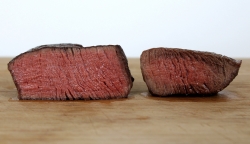

Why cook sous vide? The results are obvious. Take these two tenderloin steaks, for example. They’ve both been cooked to 130ºF (medium-rare), but they look strikingly different. The steak on the left has been cooked using the Anova Precision Cooker and then quickly seared before serving. The steak on the right was seared on the stove-top and finished in a hot oven. The steak cooked sous vide has a few distinct advantages: First, it is medium rare almost completely from edge-to-edge. (There is a small, millimeter-thick browned edge that results from searing the steak to finish.) The steak cooked using the traditional method is medium-rare in the center, but has a thick, overcooked band around the edges. Second, the muscle fibers in the sous vide steak are smooth and still full of delicious, beefy juice. The steak on the right has contracted and lost some of its moisture. The grain is more fully defined and less tender. Third, if you're cooking a steak with a defined fat cap (like a ribeye or strip steak), you'll definitely want to choose the sous vide option — the fat on a sous vide steak is tender and flavorful, while the fat on a traditionally cooked steak is tough and gristly. Which would you rather eat?
Kate Itrich-Williams